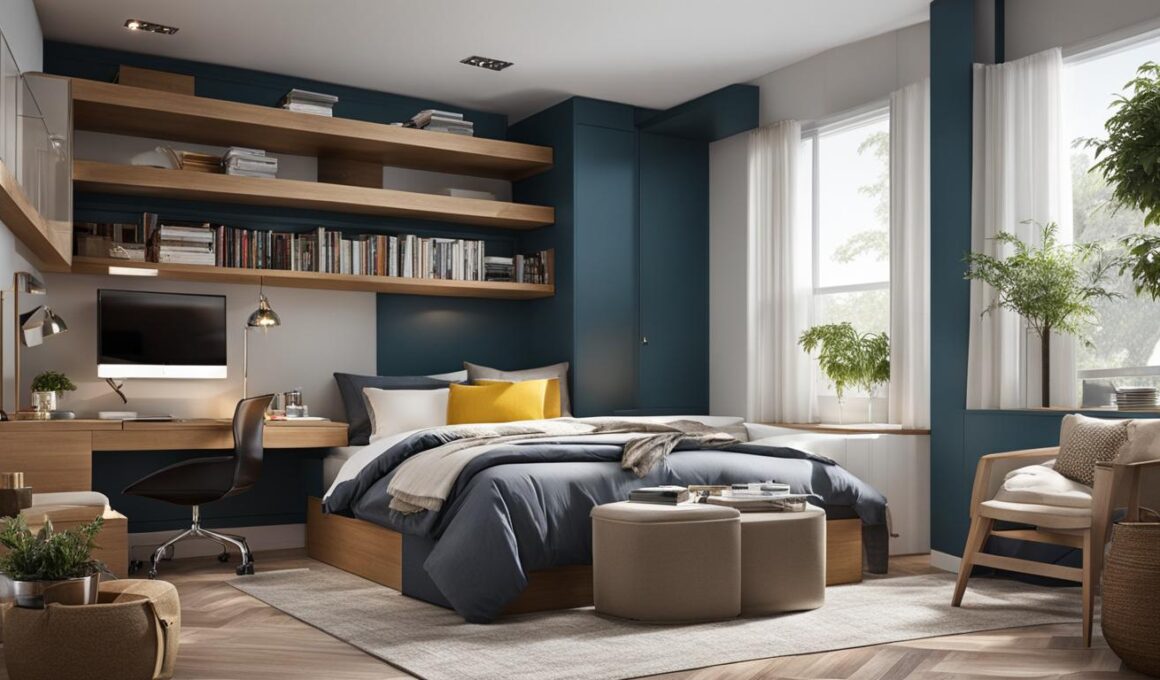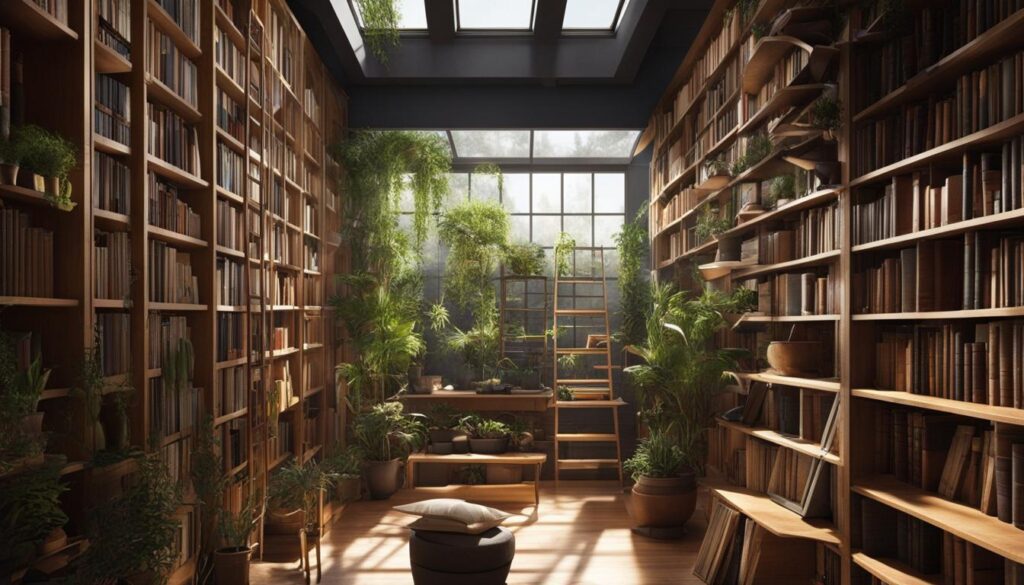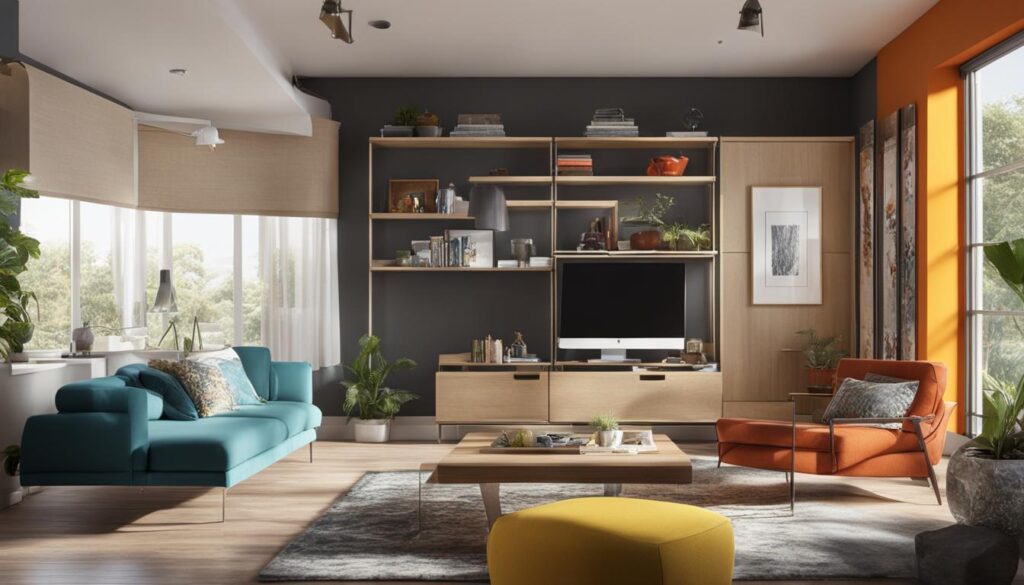Small spaces and tiny homes are gaining popularity due to the creative and inspiring design ideas that can be applied to limited spaces. The growing demand for affordable and sustainable living, along with the rising costs of owning homes, has led many people to seek out clever design solutions for maximizing small spaces. In this article, we will explore various tips and techniques to help you make the most of your tiny rooms and homes.
Post Summary
- Vertical space utilization is essential for maximizing small rooms. Utilize shelves, wall-mounted furniture, and storage solutions to make the most of the height of your space.
- Choose multi-functional furniture that serves multiple purposes to maximize functionality and adaptability in small spaces.
- Mirrors are a powerful design tool that can create the illusion of a larger room. Strategically place mirrors to reflect light and add depth to the space.
- Light and color are crucial in creating the illusion of a larger space. Use light and neutral colors, maximize natural light, and incorporate different types of lighting to enhance the ambiance.
- Incorporate natural elements such as plants and nature-inspired accessories to create a calming and cohesive environment in small spaces.
Vertical Space Utilization
Designing for vertical space is a crucial aspect of maximizing small rooms. By utilizing the height of your rooms with shelves, cabinets, or wall-mounted furniture, you can create extra storage and make the space appear larger. Interior designers recommend investing in furniture that can be conveniently packed away or stacked on top of one another to save room.
One effective way to optimize vertical space is by installing shelves and cabinets that reach the ceiling. This not only helps to maximize storage but also creates the illusion of a taller and larger space. Consider incorporating floating shelves or floor-to-ceiling bookcases to make use of the vertical area.
Wall-mounted furniture, such as foldable tables or desks, is another great solution for small spaces. These pieces can easily be folded up and tucked away when not in use, freeing up valuable floor space. Additionally, wall-mounted storage units can provide a practical and stylish solution for keeping items organized without taking up valuable square footage.
Remember that when designing for vertical space, it’s important to consider the weight-bearing capacity of your walls and ensure proper installation to maintain safety and stability. By strategically utilizing vertical space, you can transform your small room into a functional and visually appealing area.
“Utilizing vertical space in small rooms is a game-changer. By investing in shelves, cabinets, and wall-mounted furniture, you can create additional storage and make the space feel more spacious.”
| Benefits of Vertical Space Utilization | Considerations for Vertical Space Utilization |
|---|---|
|
|
Tips for Vertical Space Utilization
1. Install shelves and cabinets that reach the ceiling to maximize storage and create the illusion of a taller space.
2. Invest in wall-mounted furniture, such as foldable tables or desks, to save floor space and enhance flexibility.
3. Consider utilizing floating shelves or floor-to-ceiling bookcases for a stylish storage solution.
4. Ensure proper installation of wall-mounted furniture and consider weight-bearing capacity for safety.
By taking advantage of vertical space, you can transform cramped rooms into functional and visually appealing spaces that make the most of the available area.
Multi-functional Furniture
In small spaces, maximizing functionality is key. Choosing multi-functional furniture is a smart solution to make the most of your limited square footage. These versatile pieces serve multiple purposes, allowing you to adapt the space according to your needs and lifestyle. Whether you live in a tiny apartment or a compact studio, multi-functional furniture can help you create a comfortable and practical living environment.
One popular example of multi-functional furniture is the sofa bed. This piece of furniture serves as both a sofa during the day and a bed at night, making it perfect for accommodating guests or maximizing seating options in a small living room. Another versatile option is a dining table that can be transformed into a desk. This allows you to have a dedicated workspace without sacrificing precious floor space. Additionally, ottomans with hidden storage compartments and coffee tables with lift-tops provide extra storage solutions while serving their primary functions.
When selecting multi-functional furniture, it’s important to consider the overall design and style of your space. Look for pieces that seamlessly blend with your existing decor and provide the necessary functionality. By choosing furniture that serves multiple purposes, you can optimize your small space and create a more organized and efficient living area.
| Benefits of Multi-functional Furniture | Examples |
|---|---|
|
|
By incorporating multi-functional furniture into your small space, you can enjoy the benefits of versatility and practicality while maintaining a stylish and cohesive design. These innovative pieces allow you to make the most of every square inch, ensuring that no space is wasted. So, whether you’re looking to optimize your small apartment or add functionality to a compact room, consider the power of multi-functional furniture to transform your space into a functional and beautiful haven.
The Power of Mirrors
Mirrors are a powerful design tool in small spaces as they reflect light and create the illusion of a larger room. Hanging a large mirror on a wall or placing it strategically behind furniture, like a sofa or bed, can reflect light and make the space appear more spacious and airy. Mirrors also add depth and visually expand the room, making them an essential element in maximizing small spaces.
Now let’s move on to the role of color in creating the illusion of space. When choosing colors for your small space, opt for light and neutral tones. Whites, creams, and pastels can help make a room feel more open and airy. These colors reflect light, creating a sense of brightness and expanding the visual boundaries of the space. Consider painting your walls in light shades and incorporating furniture and decor in complementary hues. By maintaining a cohesive color palette, you can create a seamless and visually appealing environment.
In addition to light and color, the placement and direction of windows also play a significant role in the overall ambiance of the room. Consider positioning furniture near windows to take advantage of natural light and create a connection to the outdoors. This not only brings in more light but also provides a sense of openness and freshness. By strategically designing around windows, you can maximize the impact of light and create an inviting space.
Incorporating Natural Elements
When it comes to maximizing small spaces, incorporating natural elements can make a world of difference. Adding plants and flowers not only brings life and freshness to your space but also creates a sense of the outdoors, making the room feel more spacious and calming.
Plants have a unique ability to add texture and depth to any room. You can choose from a variety of low-maintenance plants that are perfect for small spaces, such as succulents or air plants. Hanging plants or wall-mounted planters are excellent options if you are short on floor space.
In addition to plants, consider incorporating nature-inspired accessories. Items like woven baskets, rustic wooden furniture, or artwork depicting natural landscapes can create a cohesive and harmonious environment. These elements add visual interest and enhance the overall aesthetic of the space.
By embracing natural elements in your small space, you can create a tranquil oasis that feels open, inviting, and connected to the beauty of the outdoors. So go ahead, bring a touch of nature into your home and watch as your space transforms into a serene sanctuary.
FAQ
How can I maximize small spaces with clever design solutions?
By utilizing vertical space with shelves, cabinets, and wall-mounted furniture, choosing multi-functional furniture, incorporating mirrors, using light and neutral colors, and adding natural elements.
What are some tips for utilizing vertical space in small rooms?
You can maximize vertical space by installing shelves and cabinets that reach the ceiling, using wall-mounted furniture, and investing in furniture that can be conveniently packed away or stacked.
How can multi-functional furniture help maximize the functionality of small rooms?
Multi-functional furniture, such as a sofa bed, dining table that turns into a desk, ottoman with storage, or a coffee table with a lift-top, allows you to easily repurpose furniture and adapt the space for different activities.
How can mirrors create the illusion of a larger room in small spaces?
Mirrors reflect light and make the space appear more spacious and airy. Hanging a large mirror on a wall or placing it strategically behind furniture can visually expand the room.
How can light and color help create the illusion of a larger space?
Choosing light and neutral colors for walls and furniture creates a seamless and open flow throughout the room. Maximizing natural light, incorporating task lighting and accent lighting, and considering the placement and direction of windows enhance the ambiance and create a larger feel.
How can incorporating natural elements enhance small spaces?
Adding plants, flowers, or nature-inspired accessories brings a sense of the outdoors into the space, adds texture and depth, and creates a cohesive and harmonious environment.







